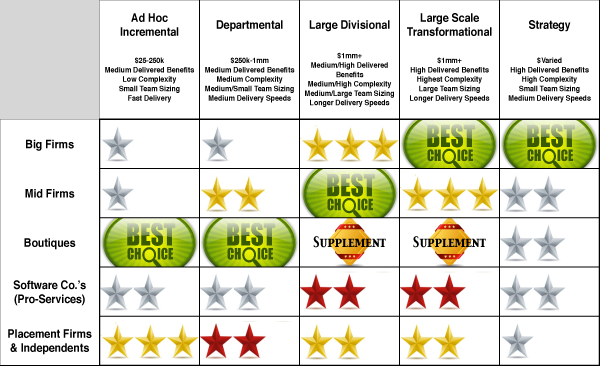In our last post we helped categorize your projects. Today, let’s look at the characteristics of external consultancies.
Consultancy Types:
Big Firms – Bring to bear resources across a broad spectrum of industries, technologies and functional areas. Can meet the needs of the largest of large inititiatives domestically and globally. Big firms will primarily focus only on these large initiatives to move their “revenue meters”.
Mid Sized Firms – Directly can compete with Big Firms in all but name (branding) and the largest initiatives. Often possess a core strength upon which they were initially founded; be that industry, functionally or technology.
Management Consulting & Technology Boutiques – Typically made their name in a specific industry, functional area or technology. Great work, word of mouth and/or a hot technology have allowed growth into larger team based deliveries.
Software/Platform Specific Vendors – The professional services division of a software vendor. They possess a very high degree of knowledge in their own product and often the specific business functions their product aligns to.
Staffing / Placement Agencies – Focused on augmenting teams, and single resource placements.
Independent Consultants – Independents are typically used to augment projects or fulfill gaps in on-going operational activities. Specialities, acumen, and skill sets will vary tremendously. Note: in the context described here are truly independent workers, not joined to or aligned with any of our previous categories.
Internal Resources – Although not part of any external consulting organization, may at times augment 10-50+% of any given project’s team size. These internal resources are “do’ers” and officially allocated to a project, even if only part-time. This category does not include business stakeholders that may provide input throughout a project.
Consultancy Characteristics:
Total Cost of Pricing – The total cost of doing business excluding travel (see below). This includes: base consultant rates, over-time, over-head costs (partners, directors) and retainers.
Client Focused Flexibility – Willingness and ability to make common sense changes occur quickly for clients. Do small scope changes require a change order? Do legal contracts and statements of work take weeks to negotiate? Do you lack access to frequently interact with the firm’s top management?
Team Focused Delivery – Turn key ability to resource all major aspects of a team’s makeup if so requested.
Lean Staffing Models – Does the consultancy take an aggressive approach to lean project staffing?
Does the consultancy allow for its’ resources to cross over into different roles simultaneously? Are all resources efficiently allocated and being utilized to the fullest?
Bench Strength – The ability to meet project resourcing demands with the appropriate talent level.
Travel Related Expenses / Out of Town Consultants – Are >50% of project resources typically incurring out of town travel expenses? Travel costs can quickly add up when an additional 10-20% is added to direct resourcing costs.
Stay tuned for our next post, where we’ll match resourcing options with your project types.
Figure 1. Consultancy Characteristics Summary Matrix 
Figure 2. Consultancy Strengths 
Figure 3. Consultancy Weaknesses 
About Us:
At CompassX we know all about strategy implementation and project execution excellence. To learn more:

